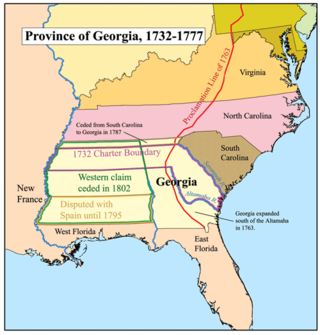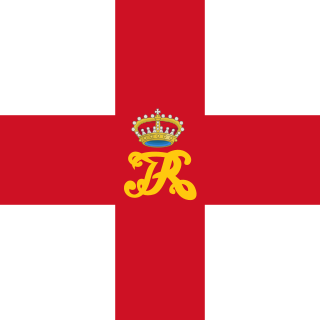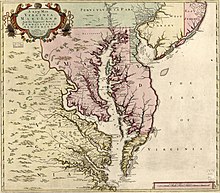
The Thirteen Colonies were a group of British colonies on the Atlantic coast of North America during the 17th and 18th centuries. Grievances against the imperial government led the 13 colonies to begin uniting in 1774 and expelling British officials by 1775. Assembled at the Second Continental Congress in Philadelphia, they appointed George Washington as commander-in-chief of the Continental Army to fight the American Revolutionary War. In 1776, Congress adopted the Declaration of Independence as the United States of America. Defeating invading British armies with French help, the Thirteen Colonies gained sovereignty with the Treaty of Paris in 1783.
This section of the timeline of United States history concerns events from before the lead up to the American Revolution.

The Middle Colonies were a subset of the Thirteen Colonies in British America, located between the New England Colonies and the Southern Colonies. Along with the Chesapeake Colonies, this area now roughly makes up the Mid-Atlantic states.

The governments of the Thirteen Colonies of British America developed in the 17th and 18th centuries under the influence of the British constitution. After the Thirteen Colonies had become the United States, the experience under colonial rule would inform and shape the new state constitutions and, ultimately, the United States Constitution.

The Province of New Jersey was one of the Middle Colonies of Colonial America and became the U.S. state of New Jersey in 1776. The province had originally been settled by Europeans as part of New Netherland but came under English rule after the surrender of Fort Amsterdam in 1664, becoming a proprietary colony. The English renamed the province after the island of Jersey in the English Channel. The Dutch Republic reasserted control for a brief period in 1673–1674. After that it consisted of two political divisions, East Jersey and West Jersey, until they were united as a royal colony in 1702. The original boundaries of the province were slightly larger than the current state, extending into a part of the present state of New York, until the border was finalized in 1773.

The Southern Colonies within British America consisted of the Province of Maryland, the Colony of Virginia, the Province of Carolina, and the Province of Georgia. In 1763, the newly created colonies of East Florida and West Florida would be added to the Southern Colonies by Great Britain until the Spanish Empire took back Florida. These colonies were the historical core of what would become the Southern United States, or "Dixie". They were located south of the Middle Colonies, albeit Virginia and Maryland were also called the Chesapeake Colonies.
The Southern Colonies were overwhelmingly rural, with large agricultural operations, which made use of slavery and indentured servitude extensive. During a series of civil unrest, Bacon's Rebellion shaped the way that servitude and slavery worked in the South. After a series of attacks on the Susquehannock, attacks that were ensued after the group of natives burnt one of Bacon's farms, Bacon's arrest, along with other arrest warrants, were issued by Governor Berkely, for attacking the natives without his permission. Bacon avoided detainment, though, and then burnt Jamestown, in opposition of the governor previously denying him land in fear of native attacks, however Bacon hadn't believe his policies were entirely conventional, saying that they didn't ensure protection to the English settlers, as well as the exclusion of Bacon from Berkeley's social clubs and friend groups. The rebellion dissolved sometime in 1676, following Charles II's initial sending of troops to restore order in the colony. This rebellion influenced the view of the Africans, helping create a completely African servitude and workforce in the Chesapeake Colonies, alleviating primarily White servitude, a working-class that could be repugnant at times through disobedience and mischief. This also helped racial superiority in White regions, helping the poor White and wealthy White people, respectively, feel almost equal. It diminished alliances between White and Black people, happened in Bacon's Rebellion.
The colonies developed prosperous economies based on the cultivation of cash crops, such as tobacco, indigo, and rice. An effect of the cultivation of these crops was the presence of slavery in significantly higher proportions than in other parts of British America.

The Province of Maryland was an English and later British colony in North America from 1634 until 1776, when it made common cause with the group of Thirteen Colonies in rebellion against Great Britain and, finally in 1781—as the 13th signatory to the Articles of Confederation—it ratified its perpetual union with that group as the state of Maryland. The province's first settlement and capital was St. Mary's City, located at the southern end of St. Mary's County, a peninsula in the Chesapeake Bay that is bordered by four tidal rivers.

The Province of Carolina was a province of the Kingdom of England (1663–1707) and later the Kingdom of Great Britain (1707–1712) that existed in North America and the Caribbean from 1663 until the Carolinas were partitioned into North and South on January 24, 1712.

The Dominion of New England in America (1686–1689) was an administrative union of English colonies covering all of New England and the Mid-Atlantic Colonies, with the exception of the Delaware Colony and the Province of Pennsylvania. The region's political structure was one of centralized control similar to the model used by the Spanish monarchy under the Viceroyalty of New Spain. The dominion was unacceptable to most colonists because they deeply resented being stripped of their rights and having their colonial charters revoked. Governor Edmund Andros tried to make legal and structural changes, but most of these were undone and the Dominion was overthrown as soon as word was received that King James II had left the throne in England. One notable change was the forced introduction of the Church of England into Massachusetts, whose Puritan leaders had previously refused to allow it any sort of foothold.

William Claiborne also, spelled Cleyburne was an English pioneer, surveyor, and an early settler in the colonies/provinces of Virginia and Maryland and around the Chesapeake Bay. Claiborne became a wealthy merchant and planter, as well as a major political figure in the mid-Atlantic colonies. He featured in disputes between the colonists of Virginia and the later settling of Maryland, partly because of his earlier trading post on Kent Island in the mid-way of the Chesapeake Bay, which provoked the first naval military battles in North American waters. Claiborne repeatedly attempted and failed to regain Kent Island from the Maryland Calverts, sometimes by force of arms, after its inclusion in the lands that were granted by a 1632 Royal Charter to the Calvert family. Kent Island had become Maryland territory after the surrounding lands were granted to Sir George Calvert, first Baron and Lord Baltimore (1579–1632) by the reigning King of England, Charles I.

A Crown colony or royal colony was a colony governed by England, and then Great Britain or the United Kingdom within the English and later British Empire. There was usually a governor to represent the Crown, appointed by the British monarch on the advice of the UK Government, with or without the assistance of a local council. In some cases, this council was split into two: an executive council and a legislative council, and the executive council was similar to the Privy Council that advises the monarch. Members of executive councils were appointed by the governors, and British citizens resident in Crown colonies either had no representation in local government, or limited representation in a lower house. In several Crown colonies, this limited representation grew over time. As the House of Commons of the British Parliament has never included seats for any of the colonies, there was no direct representation in the sovereign government for British subjects or citizens residing in Crown colonies.

The territorial evolution of the British Empire is considered to have begun with the foundation of the English colonial empire in the late 16th century. Since then, many territories around the world have been under the control of the United Kingdom or its predecessor states. When the Kingdom of Great Britain was formed in 1707 by the union of the Kingdoms of Scotland and England, the latter country's colonial possessions passed to the new state. Similarly, when Great Britain was united with the Kingdom of Ireland in 1801 to form the United Kingdom, control over its colonial possessions passed to the latter state. Collectively, these territories are referred to as the British Empire. When much of Ireland gained independence in 1922 as the Irish Free State, the other territories of the empire remained under the control of the United Kingdom.
A lord proprietor is a person granted a royal charter for the establishment and government of an English colony in the 17th century. The plural of the term is "lords proprietors" or "lords proprietary".
A charter is a document that gives colonies the legal rights to exist. Charters can bestow certain rights on a town, city, university, or other institution.
Charter colony is one of three classes of colonial government established in the 17th century English colonies in North America, the other classes being proprietary colony and royal colony. These colonies were operated under a corporate charter given by the crown. The colonies of Virginia, Rhode Island, Connecticut, and Massachusetts Bay were at one time or another charter colonies. The crown might revoke a charter and convert the colony into a crown colony. In a charter colony, Britain granted a charter to the colonial government establishing the rules under which the colony was to be governed. The charters of Rhode Island and Connecticut granted the colonists significantly more political liberty than other colonies. Rhode Island and Connecticut continued to use their colonial charters as their State constitutions after the American Revolution.

The situation of the Catholic Church in the Thirteen Colonies was characterized by an extensive religious persecution originating from Protestant sects, which would barely allow religious toleration to Catholics living on American territory. Nonetheless, Catholics were a part of colonial history from the beginning, especially in Maryland, a colony founded by Catholics, and Rhode Island, a colony founded explicitly for religious toleration. The situation was complicated greatly by the evolving role of the English Crown, which acted as both Supreme Governor of the Church of England and the Head of State of the thirteen colonial governments in almost all periods of colonial rule.
Edward Randolph was an English colonial administrator, best known for his role in effecting significant changes in the structure of England's North American colonies in the later years of the 17th century.

The English overseas possessions, also known as the English colonial empire, comprised a variety of overseas territories that were colonised, conquered, or otherwise acquired by the former Kingdom of England during the centuries before the Acts of Union of 1707 between the Kingdom of England and the Kingdom of Scotland created the Kingdom of Great Britain. The many English possessions then became the foundation of the British Empire and its fast-growing naval and mercantile power, which until then had yet to overtake those of the Dutch Republic, the Kingdom of Portugal, and the Crown of Castile.










